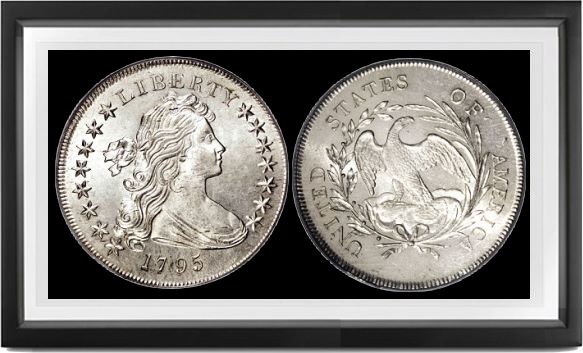Park Avenue Numismatics
5084 Biscayne Blvd, Suite 105
Miami, FL 33137
Toll Free: 888-419-7136
Secure Private Ordering
We use the latest online security processing,
so your order is safe & private.
We DO NOT disclose any customer
information to ANY third party company.
Our customer privacy is our priority.
Over 30 Years Experience
Park Avenue has over 30 years
experience buying and selling
Rare Coin and Precious Metals.
We have the knowledge and
ability to provide our customers
with the best products and services.




THE FLOWING HAIR SILVER DOLLAR, 1794-1795
 "Statute One," the Mint Act of April 2, 1792, authorized coinage of silver dollars at the weight of 416 grains (26.96 grams) and the awkward fineness of 1485/1664 silver, 179/1664 copper (= 892.43 + fine), The coins were supposed to pass at par with Spanish and Mexican dollars, though the imperfect assaying methods available at the time prevented the authorities from learning the true Spanish standard (65/72 = 902.77 + fine). However, as the Spanish and Mexican dollars were made legal tender at the same amount, worn ones circulated preferentially, not much bullion being brought in for coinage into US. dollars.
"Statute One," the Mint Act of April 2, 1792, authorized coinage of silver dollars at the weight of 416 grains (26.96 grams) and the awkward fineness of 1485/1664 silver, 179/1664 copper (= 892.43 + fine), The coins were supposed to pass at par with Spanish and Mexican dollars, though the imperfect assaying methods available at the time prevented the authorities from learning the true Spanish standard (65/72 = 902.77 + fine). However, as the Spanish and Mexican dollars were made legal tender at the same amount, worn ones circulated preferentially, not much bullion being brought in for coinage into US. dollars.
The Assayer, Albion Cox, complained that the prescribed fineness was too cumbersome to work with, and recommended a diminution of the copper to 10%, which would have meant a standard of weight of 412.5 grains (26.73 grams)—exactly as Congress was to authorize in 1837. But Congress violently opposed any such change then, whereupon Mint Director David Rittenhouse proposed that the silver content be increased from 371.25 to 374.75 grains out of the 416, which again meant an increase to 900/1000 fineness. With the approval of Thomas Jefferson and Alexander Hamilton, and expecting early Congressional approval, Rittenhouse, began coining dollars at this new standard, some 1,758 pieces being delivered October 15, 1794, and 203,033 through October 1795, at this unauthorized standard—barely within the legal tolerance or "remedy." From the point of view of depositors of silver bullion, this meant that about 2.5 grains extra silver had to be put into each dollar they received, representing a net loss of about 1%. The biggest such depositor, John Vaughan, computed his total loss at some $2,260, and went to Congress demanding reimbursement, which finally came through in February 1800.
The silver dollars of 1794 were from a single pair of dies cut by Robert Scot, Philadelphia engraver of bank note plates. They were criticized at once for weakness of impression: "the touches of the graver are too delicate, and there is a want of that boldness of execution which is necessary to durability and currency" (New Hampshire Gazette, December 2, 1794, cited by Taxay, p. 106). The fault, however, is less in the die than in alignment: on most specimens, the two dies were not in parallel planes, so that the left side of the coin is weaker—especially the date, stars at left, and UNITED STATES. Specimens with all these details strong are very rare. The peculiar figure of 1,758 coined is believed to represent the acceptable moiety of probably 2000 actually struck that day, the remaining 242 being rejected as too weak and retained in the Coiner's vault, being used in the middle of 1795 as blanks, A single example of the Bolender 9 (The United States Early Saver Dollars from 1794 to 1803, by M. H. Bolender) variety of 1795 shows plain traces of having been overstruck on one of these weak 1794 dollars.
The original 1,758 dollars of 1794 were turned over to David Rittenhouse for distribution to VIPs and others as souvenirs. Over fifty are traced today in all condition grades, at least ten qualifying as full Mint State. One of the two obtained by Major the Lord St. Oswald in October 1795 at his visit to the Mint, and continuously traced from that day to its appearance in the "Gilhousen" sale of October 1-4, 1973, was bid up to $110,000 while TV cameras whirred, as a kind of apogee of the demand for dollars of this initial year.
The same designs were continued into 1795, some 160,295 Flowing Hair dollars being struck through mid October (the other 42,738 of that month were of the new Draped Bust design). Some 19 varieties are known from ten pairs of dies, only three of which can be considered common. Two reverses, one common, have bunches of three leaves below wings, while all others have only double leaves there, resulting in a demand for both kinds as type coins. Fortunately, one variety of each type is common in all grades. It is estimated that between 3% and 4% survive of the original mintages.
Click here to view our current inventory of Flowing Hair Dollars












